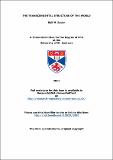Files in this item
The transcendental structure of the world
Item metadata
| dc.contributor.advisor | Timmermann, Jens | |
| dc.contributor.author | Bader, Ralf M. | |
| dc.coverage.spatial | 110 | en_US |
| dc.date.accessioned | 2011-06-22T14:16:15Z | |
| dc.date.available | 2011-06-22T14:16:15Z | |
| dc.date.issued | 2010 | |
| dc.identifier.uri | https://hdl.handle.net/10023/1890 | |
| dc.description.abstract | This dissertation provides a systematic account of the metaphysics of transcendental idealism. According to the proposed theory, appearances are understood as intentional objects, while phenomena are considered as logical constructs that are grounded in noumena, whereby the grounding relation can be modelled by means of a coordinated multiple-domain supervenience relation. This framework is employed to provide a vindication of metaphysics, by giving dual-level explanations that explain how the world can have ontological structure, making intelligible the applicability of metaphysical concepts, such as unity, persistence, causation and mind-body interaction, to the empirical realm. The key claim that is advanced in the dissertation is that in order to be realists we have to be transcendental idealists. In particular, transcendental arguments are provided that establish that if realism about science, metaphysics and ethics is to be possible, then (i) the world must have a transcendental structure that integrates the fragmented perspective-dependent spatio-temporal frameworks into a unified perspective-independent space-time manifold, (ii) space and time must be forms of intuition that give rise to correspondences between appearances and phenomena, making it the case that we can have non-trivial scientific knowledge of the world, and (iii) we must have a priori concepts, namely the mathematical and dynamical categories, that allow us to cognise the empirical as well as ontological structure of the world. The ‘fact of experience’ as well as the ‘fact of reason’ are then brought in to strengthen the case for scientific, metaphysical and moral realism, thereby warding off the threat of nihilism. Moreover, a refutation of the more attractive versions of scepticism and idealism is provided, namely of those versions that claim that a subject’s representations or episodes of awareness can be temporally ordered even though they deny or doubt the existence of a law-governed external world. The conclusion then is that a realist stance is to be adopted and that we should consequently accept transcendental idealism and hold that the world has a transcendental structure. | en_US |
| dc.language.iso | en | en_US |
| dc.publisher | University of St Andrews | |
| dc.subject | Transcendental idealism | en_US |
| dc.subject.lcc | B823.B23 | |
| dc.subject.lcsh | Transcendentalism | en_US |
| dc.subject.lcsh | Idealism | en_US |
| dc.title | The transcendental structure of the world | en_US |
| dc.type | Thesis | en_US |
| dc.type.qualificationlevel | Doctoral | en_US |
| dc.type.qualificationname | PhD Doctor of Philosophy | en_US |
| dc.publisher.institution | The University of St Andrews | en_US |
This item appears in the following Collection(s)
Items in the St Andrews Research Repository are protected by copyright, with all rights reserved, unless otherwise indicated.

